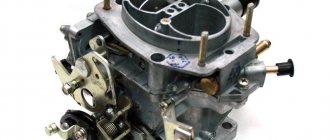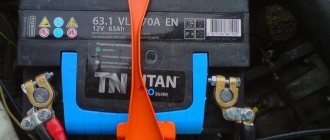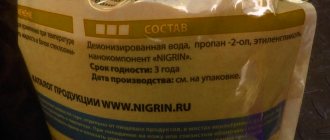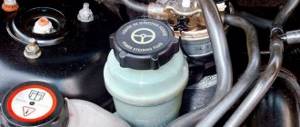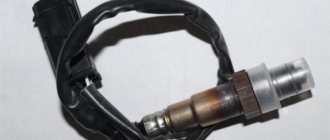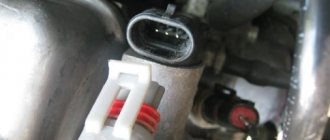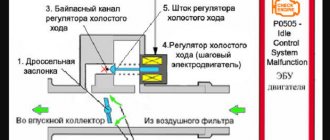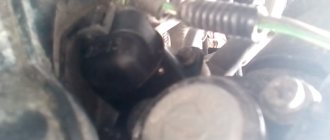The “Jager”’s heart began to play pranks. When I pressed the gas pedal, some kind of step appeared, and the idle started to float. This became especially clear after removing the battery terminals when installing the battery cover. I decided that it was time to clean the throttle valve, and at the same time check the mass air flow sensor (MAF). The process of disassembling and removing the throttle valve has already been described many times, so we’ll skip it. This is what I saw.
The damper is quite overgrown. I approached the choice of a carburetor cleaner or carb cleaner thoroughly, re-read a bunch of articles and came across an interesting video, which resolved my issue with the choice.
To be fair, I tried cleaning my damper with WD-40 before using Hi-Gear. Of course, the Vedeshka gradually dissolves deposits on the throttle, but not as quickly as we would like. But Hi-Gear coped with its task with 5+, after 5 seconds of use I had an absolutely clean damper in my hands.
Let's move on to the mass air flow sensor (MAF).
According to statistics, problems with this sensor begin after 100,000 km. But I wondered what it was like for me after 42,000 km. Moreover, getting it out is not difficult: remove the connector and unscrew two screws.
My mass air flow sensor housing was lightly dusted with fine dust. Not critical, but I decided to wash off this pollen. Now ATTENTION! This sensor can only be washed with alcohol or a product specially designed for cleaning MAF sensors. Under no circumstances should you wash with any other products containing acetone or solvents. I’ll quote a colleague from the OlegNeo drive, he sorted everything out.
Mass air flow sensor (MAF)
(MAF) is designed to measure the mass air flow consumed by the internal combustion engine of a vehicle combined with an integrated microprocessor fuel injection control system
Mass air flow sensor belongs to the so-called hot-wire type sensors. It measures the mass of air entering the engine, helping to determine the amount of fuel required for injection. It is installed between the air filter and the throttle pipe. The task of the mass air flow sensor is to maintain the resistance of the temperature-dependent sensing element at a constant level. You can say it another way - not resistance, but temperature. In this case we are talking about a thermistor - a filament made of a platinum-iridium alloy. Due to its duty, it heats up to a fixed temperature higher than the ambient temperature. The air flow passing through it constantly affects the amount of heat it dissipates - the more air, the better the cooling and the lower the temperature. As a result, the resistance of the thread changes - to return it to its previous level, the electronic filling changes the current passing through it. The latter can actually already serve as a measure for determining mass air flow, but in practice it is not current, but voltage that is used. Generally speaking, there are not one, but two thermally dependent elements in the sensor. One, as we have already found out, measures flow, while the second measures external temperature, compensating for possible temperature errors.
Under no circumstances should you blow it with air from the compressor. You can break the conductors from the crystal to the board. They are very thin (approx. 0.01mm), it looks like they are made of silver or platinum (I’m not sure). But very soft. They are fixed with a gel-like compound, which is dissolved by light solvents and deformed by a strong air flow. Those. By “blowing” with a compressor, you can “blow away” the compound and tear off the conductors. Ketones and ethers should not be used for washing. For three reasons: 1. The compound is dissolved. 2.When drying, cool the crystal very strongly. It can “burst, crack.” 3. Dissolve the “mask” on the crystal (this is relatively not scary, but in the center of the crystal there is a polymer film in the window, it looks like it’s made of polyethylene terephthalate, which also has a mask and metal coating). The film is not scary, but if the mask is washed off, the film will deform and come off.
How to clean the air flow sensor?
To clean the sensor, we still have the well-known wd-40 and “Liquid Key”.
They contain diesel fuel with heavy fatty acids, so they leave a film. This film can be washed off with alcohol: from methyl to ethyl and isopropyl. From them you need to make a mixture with distilled water in an alcohol/water ratio of 5 to 1. Do not use commercial alcohol. goods - it is dirty. The ideal cleaning solution would be isopropyl alcohol at a temperature of 55-75 degrees.
Cleaning the air flow sensor on a VAZ.
For the so-called repair of the mass air flow sensor we will need:
- cleaning and rinsing liquids;
- syringe;
- flat screwdriver.
- We remove the mass air flow sensor. To find out how to remove the mass air flow sensor, read the article
- We unscrew the sensor element, which is attached to two special bolts. Such bolts can be unscrewed with a regular flat-head screwdriver.
- We take a syringe with liquid and at a distance of 5-10cm. spray on all parts of the sensor: contacts, diode, holes, etc.
- For prevention, we clean the wire connection block and their contacts.
- We rinse everything with the same syringe and let it dry.
- We install and check.
- If it does not help, then the process can be repeated again. If the sensor still does not work, you will have to buy a new one.
Every car enthusiast who understands the design of cars knows what an air flow sensor is and what functions it performs. However, not every motorist has an idea of how to clean the mass air flow sensor with your own hands and what is needed for this. In this article we will talk in detail about the cleaning process and the choice of substance for this purpose.
[Hide]
How to check for a faulty air flow sensor?
The parameters transmitted by the mass air flow sensor play a large role in the balanced formation of the combustible mixture. Accordingly, breakdowns associated with the operation of the air sensor can lead to disruption of the functionality of the system as a whole. In some cases, incorrect operation of the sensor may make it impossible to start the engine.
Let's look at the signs by which you can determine if the mass air flow sensor has failed:
- the Check Engine light comes on on the dashboard;
- increased fuel consumption;
- decrease in the level of power and traction of the car;
- decrease in dynamics with increasing car speed;
- Difficulty starting the engine or the impossibility of starting it at all;
- in idling mode, the unit speed will float.
Design and designation of mass air flow sensor elements
Of course, such malfunctions speak not only of, but also of other breakdowns. Therefore, a car enthusiast should know how to correctly determine the incorrect operation of the regulator. To carry out diagnostics, there are several options, the simplest of which is to turn off the power from the mass air flow sensor while the engine is running.
After the power is turned off, the machine control unit begins to operate in emergency mode; in this case, the dosage of gasoline, diesel or gas is carried out according to the readings received from the throttle. Note that in this case the idle speed may begin to increase to 1500, but in some injection engines the speed does not increase. When the mass air flow sensor is disabled, you need to drive the car. If engine performance has improved, the mass air flow sensor will need to be replaced or cleaned.
What may indicate a problem
The mass air flow sensor is designed to measure the amount of air that enters the engine per unit of time. In accordance with its indications, a combustible mixture is formed. Therefore, interruptions in the operation of the mass air flow sensor can lead to serious problems in the functioning of the engine.
The presence of these signs may indicate other problems. Therefore, it is better to conduct additional diagnostics of the air flow sensor.
Sensor diagnostics can be carried out in different ways. The simplest of them is to disconnect the power from it while the motor is running. After this you need to drive a little. If during this time an improvement in engine performance is observed, then the mass air flow sensor is faulty.
Which cleaner should you choose?
If you decide to clean the mass air flow sensor yourself, you need to choose the right product:
- Liqui Moly. To clean the regulator, you can use Liqui Moly liquid. Liqui Moly is known for all its automotive products. Products from the manufacturer Liqui Moly are characterized by high quality, as well as a considerable price. The liquid mass air flow sensor cleaner Liqui Moly is an effective product in practice. As practice and reviews from car enthusiasts show, Liqui Moly allows you to effectively get rid of contaminants and if the air sensor is in working condition, after cleaning it can work for a long time. This product is suitable for both petrol and diesel units. The cost of Liqui Moly today is about 12 USD. e.
- Alcohol. You can clean the air sensor the old fashioned way - using alcohol. Alcohol allows you to effectively break down dirt and blockages. The use of alcohol was relevant twenty years ago; today this method is rarely used. To deceive the car owner and bill him for flushing the regulator with a cleaning agent. This practice occurs frequently at our service stations.
- Liquid for cleaning carburetors. One cheap option to clean the device is to use carburetor cleaner. The cost of one cylinder is about 1.2 dollars. If you believe the reviews of car enthusiasts, this analogue is no less effective than Liqui Moly, while its cost is ten times lower.
- "Liquid Key" Also a domestic product, sold in the form of a spray. The product is intended to rid various vehicle components and assemblies of frozen contaminants.
- WD-40. Many motorists have such a tool. In practice, WD-40 has long shown its effectiveness, so many car enthusiasts use it for these purposes. It can also be used to clean the air sensor (video author - Pavel Ksenon).
Comments and reviews
At idle it stalls and jerks when driving
Hello! VAZ 2115, 1.6 l, injection mileage 40 t.km. a year ago, when starting from 1500 rpm, it doesn’t troit, after 5 minutes it troits. I restarted it, it doesn’t troit. In the urban cycle, it’s normal. On the highway 90-110, when I release the gas, it troits. Restarts and normal acceleration is sharp. Thank you.
Hello. I have the same problem, fuel consumption has increased from 8 to almost 12, when starting the engine when cold, the speed reaches normal, then immediately drops to 500, then it rises to normal until the car warms up, and when warm, the speed in drive drops to 550 -600 in reverse gear the same, the speed of my car is 800-990
Hello, yesterday the check engine light came on. Connected elm327. I use the open diag program. Error code P0172 (rich mixture). Doesn't start well. The revolutions are floating. Sometimes it just stalls. Is it the DMRV? Or maybe something else?
Cleaning the sensor yourself
How to clean the air flow sensor at home?
The process is considered using the example of a VAZ 2110 car:
- Turn off the ignition and disconnect the connector from the regulator. It is necessary to dismantle the pipe; to do this, use a wrench to unscrew the bolt or two bolts securing the mass air flow sensor to the air filter housing. The principle of turning off the regulator may vary depending on the car model.
- The regulator must be removed from the hose, otherwise flushing the mass air flow sensor will be ineffective. To dismantle the device from a VAZ car, you will need an asterisk key of the appropriate size. You will need to unscrew the screws, after which you can remove the regulator.
- It happens that there is an oil coating on the device, so it is necessary to make everything as clean as possible. To clean the regulator from deposits, you can use carburetor cleaning fluid. You can also use a special Liqui Moly cleaning agent, it all depends on your financial capabilities. But in fact, there is practically no difference between these liquids. On the film located inside, you can see several sensors made in the form of wire; they are fixed using a special resin. Using carburetor cleaner or any other product, carefully spray this sensitive component. Do this carefully so as not to damage the film. Wait a few minutes until the liquid dries and evaporates. Depending on the amount of contamination, the procedure can be repeated several times. To make the product evaporate faster, you can use a compressor or pump. It is important to remember that a lot of pressure is not required for purging; the device just needs to be dried.
To clean it, you can use other options, as already mentioned, it could be alcohol. In addition to the regulator, you can clean the hose mesh and its inner surface. Pay attention to the pipe - if its condition is poor, there are cracks and other signs of damage, it is advisable to replace it.
But that is not all. Reassemble the components in reverse order. Experts recommend replacing the filter element after this procedure. Before installing the mass air flow sensor, check the tightness of the sealing rubber. Please note that if the seal does not fit tightly, this may lead to the suction of outside air, which is not cleared of impurities. This can lead to accelerated failure of the mass air flow sensor.
In fact, the cleaning procedure allows you to restore the functionality of eight out of ten regulators. It’s worth trying to wash the sensor, because the cost of the procedure is usually 10-15 times less than buying a new regulator.
The mass air flow sensor (MAF) monitors the temperature and mass of air entering the vehicle engine. The on-board computer needs this information to determine the correct amount of fuel for all engine operating conditions. A dirty sensor can lead to excessive fuel consumption, loss of power, hard starting and stopping, and even problems with the transmission. Therefore, the need for a reliable MAF cleaner is obvious.
How to clean the mass air flow sensor
Before you begin, here are a few notes to be aware of:
- Some manufacturers recommend replacing the MAF rather than cleaning it if the hot wire or sensing elements are dirty because cleaning the wires will not restore the sensor to its original performance. However, cleaning a dirty MAF sensor may work fine in most cases.
- If your sensor is around 100,000 miles or more, you may want to consider a new replacement, especially if engine performance seems a little sluggish after cleaning.
Unlock the tab to disconnect the MAF electrical connector.
Now, if you are ready to start, make sure the ignition switch is in the "Off" position. Then set the parking brakes and open the hood.
- Disconnect the MAF electrical connector. Be careful. You may have to press down on a plastic tab or latch to release the connector.
- Remove the bolts, usually two, that hold the sensor in place. On some models it is located inside the air filter box. If necessary, consult your vehicle's repair manual.
- Remove the sensor from the air intake trunk lid or air filter box.
- Check the rubber gasket that seals the MAF to its housing. If damaged, replace it.
- Do a visual inspection. Check the sensor for overheating and, if installed, cold wires for traces of dust, dirt, debris or insects.
- Place the MAF on a workbench or similar surface and leave it on the rag. The rag will help you catch the cleaning solution runoff as you spray the sensor.
- Wear safety glasses and latex gloves.
- Clean the sensor by spraying it with cleaning solution. Follow the instructions included with your product. Whatever you do, avoid touching sensitive wires. They are fragile and can break easily.
- If the hot and cold wires are covered in dirt or debris, you can use a brush to wipe them off.
- Spray a small amount of sensor cleaning solution into a small, clean cup.
- Soak a small brush in the cleaning solution.
- Use a brush to remove dirt and debris from the wire(s).
- After cleaning the MAF, allow it to dry completely for a few minutes.
- Meanwhile, remove dust and debris from the air filter housing and air ducts. If there is dirt or debris in the ducts, the unit forces air through the air filter.
- Install the air filter correctly and close the air filter box and air duct.
- Install the MAF, make sure the rubber seal is installed correctly, and secure the sensor with the mounting bolts.
- Connect the MAF electrical connector. Make sure the tab is locked.
- If necessary, clear fault codes using a scan tool.
- Start the engine and listen to it at idle speed.
Depending on your specific model and the trouble codes set in your computer's diagnostic memory, you may need to drive several miles to improve engine performance. For example, you may still notice a rough idle. The ECM (Engine Control Module) may take some time to adjust to the new input parameters.
If cleaning does not solve your engine's performance problems and you suspect a problem with the sensor, you may want to check the MAF sensor or replace it.
A couple of recommendations:
- If you find dirt or debris attached to the wires or sensing elements, this may indicate a faulty self-cleaning circuit. You can test the "off" relay and, if necessary, the circuit. Refer to your vehicle's repair manual.
- Some manufacturers recommend replacing the air filter after cleaning the MAF.
Securely secure the clamps of the air filter assembly to prevent air leakage.
Compound
Designed to effectively remove oil, dirt, small fabric fibers and dust from the sensor without damaging it. The main components of MAF sensor cleaners are:
- Hexane, or its rapidly evaporating derivatives.
- An alcohol-based solvent (usually 91 percent isopropyl alcohol).
- Special additives that manufacturers (the main one is the Liqui Moly trademark) use to protect their copyrights. They mainly affect smell and density.
- Carbon dioxide as a retardant for the composition in a can.
The mixture is usually sold in the form of an aerosol, so the substances must be highly dispersed, not irritate the skin and not have a harmful effect on the environment. The physical and mechanical characteristics of the most commonly used compounds (for example, Luftmassensensor-Reiniger from Liqui Moli) are:
- Density, kg/m 3 - 680...720.
- Acid number – 27…29.
- Ignition temperature, º C – not less than 250.
How to use?
Cleaning the air flow sensor must be performed whenever the air filters are changed. The sensor itself is located in the air channel between the filter box and the throttle body. Using a special tool, the device is carefully disconnected from the electrical connectors.
Some brands of cars are equipped with mechanical flow meters. They do not have measuring wires, and therefore are less sensitive to the thoroughness of dismantling.
Next, 10 to 15 sprays are applied onto the wire or sensor plate. The composition is applied to all sides of the sensor, including terminals and connectors. Platinum wires are very thin, so they cannot be wiped. After the composition has completely dried, the device can be returned to its original place. A good spray should not leave marks or streaks on the surface of the air flow sensor.
Features of application
The nuances are determined by the brand of car that has a mass air flow sensor. In particular, the choice of installation tools used to unscrew the fasteners depends on this.
You should never use MAF cleaner while the engine is running or the ignition is on. This can cause serious damage to the sensor, so it should only be disconnected when there is no current in the system.
Before spraying, place the sensor on a clean towel. Cleaning must be done so as not to touch any of the sensitive elements with the nozzle of the aerosol head.
To improve the cleaning effect, it is recommended to pre-wash the surface of the air flow sensor. To do this, place the unit in a plastic bag filled with isopropyl alcohol and shake vigorously several times. After drying, apply mass air flow sensor cleaner.
Step-by-step process
Purchase the required liquid, take a disposable syringe and a flat-head screwdriver. Even if you are a pro and know every crack of your car, still read the instructions again on how to clean the mass air flow sensor on a VAZ 2114. If you opened the hood of your fourteenth for the first time and you feel itchy, pray that everything goes smoothly, while reading the instructions at the same time.
- We opened the hood, found the sensor, removed it (loosen the fastening of the air filter hose with the sensor, unscrew the two nuts with a ten-socket wrench and voila, done);
- There is a part on the sensor that is screwed to its body with two bolts; it must be unscrewed;
- Inside, we spray the necessary liquid from a syringe onto the sensitive element (you can also rinse the contact system of the block);
- Let it dry.
Is it possible to clean the air flow sensor with carburetor cleaner?
Not recommended for use with electronic sensors! The chemicals contained in these products can cause irreversible damage to sensitive elements. However, the use of such compositions for cleaning mechanical flow meters is not excluded. However, here too it is better to use specialized substances, for example, budget cleaners offered by the Kerry brand.
It is necessary to warn owners of cars equipped with similar sensors against other errors:
- Cleaning with more active solvents: this may cause deformation of the plastic parts of the sensor itself and its housing.
- Using cleaner brands not recommended by the vehicle manufacturer.
- Cleaning the mass air flow sensor with products that are used to clean the throttle body.
- Reinstall the unit that has not dried after treatment.
A clean sensor can restore 4 to 10 horsepower to the car, which is well worth the time and expense of cleaning. It is recommended to perform such prevention once a year.
A car engine is a complex system consisting of many components. To operate in each mode, the engine requires a mixture of air and gasoline. The mass air flow sensor sets and regulates the volume of air entering the engine cylinders. During the operation of the car, the mass air flow sensor can become clogged and fail, and therefore it will be useful to know how to clean this device.
When is it necessary to clean the air flow sensor?
Everyone knows that the high-quality and productive operation of the 2112 engine, as well as fuel consumption, largely depend on how correctly the process of mixing it with oxygen occurs. That is why, the breakdown of this unit can cause serious problems in the power unit and, over time, completely disable it.
Main symptoms of a malfunction:
- Uneven, jerky and intermittent operation of the 2110 engine at idle;
- Problems with acceleration dynamics;
- Excessively low or high idle speed of the power unit;
- Inability to start the engine.
There are other signs when, in fact, the flow meter itself is in perfect order, but there are cracks in the corrugation connecting it to the throttle module. Problems and malfunctions in the operation of the mass air flow sensor can be identified by signals from the controller and the CHECK ENGINE indicator lamp. However, deciphering the displayed code yourself is quite problematic and it is better to turn to a professional for this service.
